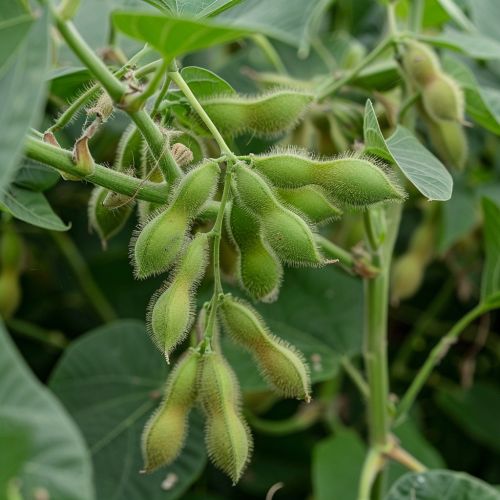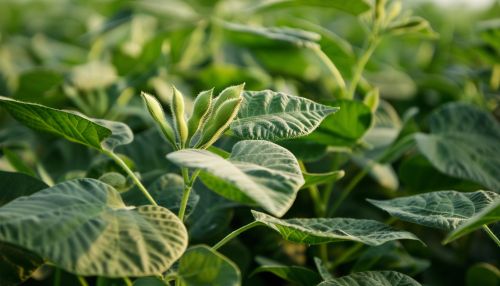Glycine max
Introduction
Glycine max, commonly known as soybean, is a species of legume native to East Asia, widely grown for its edible bean which has numerous uses. The plant is classified within the family Fabaceae and is a significant crop in terms of both its nutritional value and its economic importance. This article delves into the botanical characteristics, cultivation practices, genetic makeup, and various uses of Glycine max, providing a comprehensive understanding of this vital agricultural commodity.


Botanical Characteristics
Morphology
Glycine max is an annual herbaceous plant that can grow up to 2 meters in height. The plant has trifoliate leaves, each leaflet being oval-shaped and typically 6–15 cm long and 2–7 cm wide. The flowers are small, white to purple, and self-pollinating. The fruit is a hairy pod that usually contains 2–4 seeds.
Root System
The root system of Glycine max is characterized by a deep taproot that can extend several feet into the soil, accompanied by a network of lateral roots. The roots form symbiotic relationships with nitrogen-fixing bacteria, particularly Rhizobia, which convert atmospheric nitrogen into a form usable by the plant.
Seed Composition
Soybean seeds are rich in protein, oil, and carbohydrates. The protein content ranges from 36% to 56%, while the oil content varies between 18% and 22%. The seeds also contain significant amounts of vitamins and minerals, making them a valuable food source.
Cultivation
Climate and Soil Requirements
Glycine max thrives in a variety of climates but prefers temperate regions with well-drained, fertile soils. The ideal pH range for soybean cultivation is between 6.0 and 6.8. The plant requires a growing season of 90 to 150 days, with optimal temperatures ranging from 20°C to 30°C.
Planting and Harvesting
Soybeans are typically planted in rows spaced 30 to 90 cm apart, with seeds sown at a depth of 2.5 to 5 cm. The planting density can vary depending on the cultivar and the intended use of the crop. Harvesting usually occurs when the pods have turned brown and the seeds have reached full maturity, which is indicated by a moisture content of around 13%.
Pest and Disease Management
Glycine max is susceptible to various pests and diseases, including soybean cyst nematode, aphids, and fungal infections such as Phytophthora root rot. Integrated pest management (IPM) strategies, including crop rotation, resistant cultivars, and biological control, are commonly employed to mitigate these issues.
Genetic Makeup
Genome Structure
The genome of Glycine max is complex, comprising approximately 1.1 billion base pairs and around 46,000 genes. The plant is diploid with 20 chromosomes. Advances in genomic sequencing have facilitated the identification of genes responsible for traits such as disease resistance, yield, and stress tolerance.
Genetic Modification
Genetically modified (GM) soybeans have been developed to enhance various traits, including herbicide resistance and insect resistance. The most widely adopted GM trait is resistance to glyphosate, a broad-spectrum herbicide. These modifications have significantly impacted soybean farming practices, particularly in terms of weed management and crop productivity.
Uses
Nutritional Value
Soybeans are a major source of protein and oil for human consumption. They are processed into various products, including tofu, soy milk, and soy protein isolates. The high protein content makes soybeans a staple in vegetarian and vegan diets.
Industrial Applications
Beyond food, soybeans are used in the production of biodiesel, plastics, and other industrial products. Soybean oil is a key ingredient in the manufacture of paints, varnishes, and adhesives. The meal, a byproduct of oil extraction, is commonly used as animal feed due to its high protein content.
Medicinal Uses
Soybeans contain bioactive compounds such as isoflavones, which have been studied for their potential health benefits, including reducing the risk of cardiovascular diseases and certain types of cancer. However, more research is needed to fully understand these effects.
Environmental Impact
Soil Health
The nitrogen-fixing ability of Glycine max contributes to soil fertility, reducing the need for synthetic fertilizers. This symbiotic relationship with Rhizobia helps maintain soil health and promotes sustainable agricultural practices.
Carbon Sequestration
Soybean cultivation can play a role in carbon sequestration, as the plant absorbs carbon dioxide during photosynthesis. However, the overall environmental impact depends on various factors, including land use changes and agricultural practices.
Economic Importance
Global Production
Soybeans are one of the most widely grown crops globally, with major producers including the United States, Brazil, and Argentina. The global production of soybeans has seen a steady increase over the years, driven by the demand for protein-rich food and animal feed.
Trade and Market Dynamics
The soybean market is highly dynamic, influenced by factors such as trade policies, weather conditions, and technological advancements. Soybeans are a major commodity in international trade, with significant exports from the Americas to Asia, particularly China.
